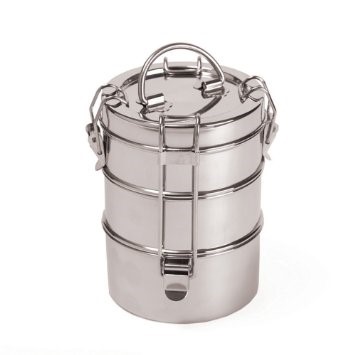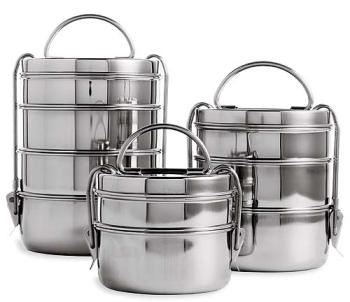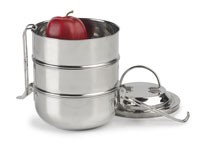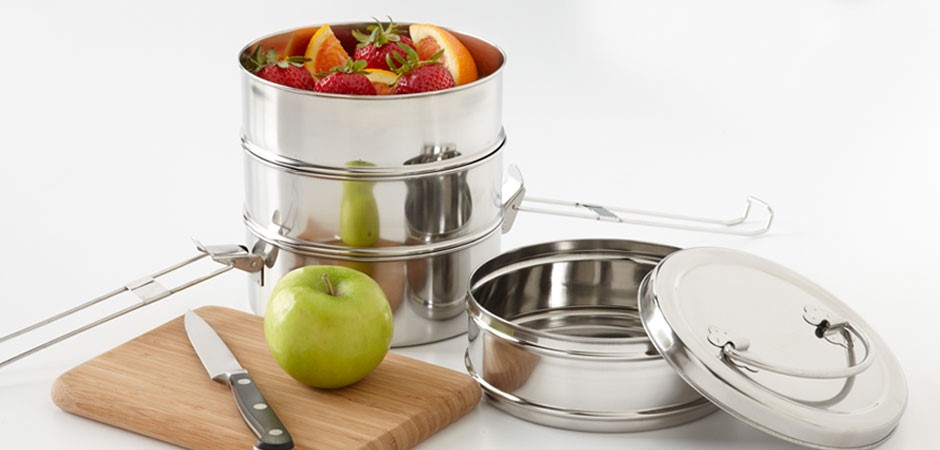Have You Packed a Tiffin Lately?
Never heard of a “tiffin?” It’s an East Indian anglicized word that means light midday meal or lunch. Therefore, a tiffin carrier meant a container that held a lunch to be eaten away from home. As time went on, “tiffin carrier” was shortened to simply “tiffin.”

Normally they come in two or three tiers, although more elaborate versions can have four. The bottom-most tier is usually the largest. In Indian and Asian cultures the bottom tier would most often hold rice. These boxes emigrated all across Europe and became the standard carrier for lunch. In Hungary, for instance, the bottom tier would typically contain a soup or other main course. And Germans tweaked the design, taking it from round to oval, and called it a “Henkelmann.”
Tiffin carriers are generally made out of stainless steel and sometimes aluminum, but enamel and plastic versions have been made by European companies. A 2-tiered tiffin is generally 5.5”D x 8.5”H, and a 3-tiered tiffin is usually 5.5”D x 11”H. They can keep food warm for at least two or three hours. Tiffin carriers are opened by unlocking a small catch on either side of the handle.

Besides the fact that they’re lovely to look at—a classy way to brown-bag—why pack a tiffin? Well, it’ll keep your sandwiches in their purest, unsquished form. You won’t have to buy any more paper or plastic lunch baggies or containers. And it’ll keep everything—salad, grains, sauces, dessert—right where it all needs to be. A two-tiered tiffin is just right for your weekday lunch, while a three-tiered tiffin is perfect for a picnic with a pal. Now get packing.

It’s considered the premier “green container” for food. For instance, I learned on the website Happy Tiffin (www.happytiffin.com) that if a person carried lunch every day of the week for a year and used just 2 plastic bags (per day) to separate courses and prevent leaks, they would use 522 plastic bags a year. Multiply that number by just half of the 3 million plus employees who carry their lunch to work, and you’ll end up with an 8 million plastic bag mess. We all know plastic is creating a nightmare for our landfills (it takes over 100 years to degrade, if it ever does), and is a waste of money for the lunch carrier. So thank goodness for the arrival of the tiffin to the American brown-bag lunch scene!
Sold? I sure am. So naturally I went hunting for sources and pricing. I found a very cool site, www.happytiffin.com, that specializes in tiffins. This is their ad copy for all their latch tiffins:

“It’s as easy as 2-3-4. Soup, salad and sandwich? Pizza, pasta and panini? With our easy-stack and re-pack Latch Tiffins, the sky’s the limit what you put in ’em. They’re durable, stylish, well-sealed and reusable – so you’re not only saving on brown lunch bags, you’re also eliminating baggies, plastic wrap, aluminum foil and all those other “one-use” materials that are wasted for food separation. The high tensile strength 201 stainless steel won’t stain, hold odors or wear out like plastic containers. And when you get home from work, school, picnic or party – just throw ’em in the dishwasher. Note: spill-proof top tier on all Latch tiffins!”
Depending on the type of tiffin you want, Happy Tiffin prices range from $10 to a little over $30 (with lots of choices in-between).
Next I checked amazon.com. They feature a 3-tier tiffin made by Gaiam that is about $25. This seems to be a standard price range for stainless steel tiffins of more than one tier. (At the time of this writing the ad said there were only 3 left.)

While no one in our home is toting a lunch anymore (thank you retirement), we do pack food when road-tripping, and the whole process can get a little messy and cumbersome. So I am seriously looking at getting a couple tiffins for this purpose. I’ll be saving up for them. I’ll keep you posted. Meanwhile, have you packed a tiffin lately?
- www.amazon.com
- www.anh-usa.org
- www.bentolunch.com
- www.happytiffin.com
 Alice Osborne
Alice Osborne
Weekly Newsletter Contributor since 2006
Email the author! alice@dvo.com
